This week I sat down with nonprofit leader, academic, and public policy guru, Allison Bauer, to discuss the do’s and don’ts of making your case for foundation support, broader trends in philanthropy, the importance of nonprofit data, and her latest role with the nonprofit strategy and consulting group, Root Cause.
Allison is the former Senior Director for Health and Wellness at The Boston Foundation as well as the former Director for the Bureau of Substance Addiction Services for the State of Massachusetts. Recently, Allison joined Root Cause as Director of Partner Relations while continuing an expanded role as an associate professor at Northeastern University.
This is the first part of a three-part series.
Sonya: Whenever our team works with a nonprofit that is aiming to secure grant support, we try to emphasize that foundations view grants as investments. Can you describe what you mean when you use the word investment?
Allison: It’s a word that covers all manner of sin – grants, mission-related investments, program investments, and non-monetary investments. When I was in philanthropy, what an investment meant to me was investing resources – whether monetary and non-monetary – to help organizations not only advance their goals in the short-term but build their capacity for longer-term success. And, for me, the best pure dollar grant I could make was time-limited and would create change that persisted.
One of my favorite grants of all time was with the City of Boston under Mayor Menino, who had a real interest in changing food systems in Boston – both from an access standpoint and a business standpoint.
The Boston Foundation, another foundation, and an individual donor gave the City of Boston money to advance this work. This was a multi-pronged effort to build access to healthy food for people of all backgrounds and to provide opportunities to build businesses for people that might not necessarily have access to a lot of capital. It was a two-year, $100,000 grant, and we never made another grant to support this effort again – because we didn’t have to.
Today, there’s an Office of Food Access, there’s an explosion of food businesses, and nation-leading programs such as one that allows individuals to use SNAP benefits at farmer’s markets and double the value of their fruit and vegetable consumption.
the best pure dollar grant I could make was time-limited and would create change that persisted.
Sonya: The competition is so fierce now amongst nonprofits for foundation grants that many organizations are left wondering what they are going to do if they can’t rely on foundations for ongoing support. Can you give us any insight into the reality nonprofits should expect in the future?
Allison: There are a couple of notable trends in philanthropy that are worth exploring here.
The first of these trends is that many foundations are now tracking and utilizing nonprofit data to guide their investment and to determine whether or not the outcomes are there.
During my time as Senior Program Officer at The Boston Foundation, I oversaw a strategy that included child welfare, disability, elderly, mental health, addiction, domestic violence, and general health services. At that time, our average investment was about $40,000/year and I probably made about 50-60 grants annually.
I’ve come to describe it as sprinkling powdered sugar over problems because there was nothing we were going to solve, with perhaps a couple of small exceptions. For the most part, these were smaller sustainability grants to help bring services to people.
Then the foundation underwent strategic planning and started considering areas where, with a more pointed investment, we could see greater success. So through research, data, and analytics through the Boston Indicators project, we learned that while here in Boston we have great healthcare, our health outcomes weren’t actually better than a lot of other places, particularly for what we were investing.
The second related trend is that foundation investments are moving upstream.
At The Boston Foundation, the data and analytics helped us determine that in order to make a real difference, we needed to move upstream – which in health, meant moving into the primary prevention space.
This wasn’t a judgment on the work of the organizations we had been supporting, but it was driven by a need to refocus our strategy to fix a more systemic problem so that – in the end – these organizations that were focused on access wouldn’t be run out of business.
So sometimes “sustainability” can be money coming directly from the foundation, but sometimes foundation investments may be designed to help create systemic change that, in the long run, contributes more broadly to sustainability across the nonprofit sector.
It’s a difficult decision for a foundation to make, but I think you are seeing more and more move into this use of nonprofit data and analytics to become more targeted with their funding. By definition, that does leave some organizations out and that is a reality.
So sometimes “sustainability” can be money coming directly from the foundation, but sometimes foundation investments may be designed to help create systemic change that, in the long run, contributes more broadly to sustainability across the nonprofit sector.
Sonya: But one of the impacts of these trends in philanthropy is that you still have a lot of smaller nonprofits who feel like they can’t compete for grants from larger foundations because their focus is on access and perhaps not on broader systems change. How would you recommend that they approach foundations to help make the case for support?
An example might be an organization that wants to open access to mental health services for individuals across the state of MA. The question is can they make the case that says, “we need support, here’s data that says individuals in more rural areas are less likely to have access to mental health services, and without that access their health outcomes are significantly reduced”?
Even though they are not creating systems change in this example, they are still reporting back to the foundation that their investment has made a difference and that; they have increased connectivity for individuals in need.
These nonprofits need to approach community foundations, family foundations, private foundations and be able to say “your foundation’s mission is to improve people’s lives – I’m telling you with data that this is a way to do it and here’s how.” You want that case to demonstrate clear mission, clear focus, and a clear pathway to impact.
These nonprofits need to approach community foundations, family foundations, private foundations and be able to say “your foundation’s mission is to improve people’s lives – I’m telling you with data that this is a way to do it and here’s how.” You want that case to demonstrate clear mission, clear focus, and a clear pathway to impact.
Allison: One of the things The Boston Foundation did after becoming laser-focused in each of our areas was to launch our Open Door Grants program so there was still an opportunity for those smaller nonprofits who didn’t have their mission aligned with our strategic priorities to access support. But we still want those organizations to be able to demonstrate impact. That’s the piece that matters.
There was a period of time [at The Boston Foundation] when our VP gave every program officer who headed an area a small amount of money for grassroots investment. So for me, while I was doing larger food systems work with the City of Boston, I was able to take those grassroots dollars and invest in a program that brought a mobile food market to Mattapan. And now, there are organizations like Fresh Truck that take school buses and turn them into mobile food markets and bring them directly into communities. That’s a lot of people now getting access to food from a grassroots idea. From my perspective, it’s incumbent on philanthropy to think small and large, to focus on the short game and the long game.
From my perspective, it’s incumbent on philanthropy to think small and large, to focus on the short game and the long game.
Sonya: You’re describing the concept of foundations having a balanced portfolio. And I love that because it leverages one of the natural strengths of the foundation sector – which is to be the lever that moves some systemic change – but at the same time it clearly recognizes that we still need philanthropy to play a role in keeping quality nonprofits sustainable.
It’s the same sort of thing that I would recommend to nonprofits around their revenue strategy – to not be oversubscribed in any single area such as government or foundation grants, but to have that risk spread across diverse revenue sources so that they can remain nimble.
We urge our nonprofit partners to always think both large and small – to not be afraid to take the big swings when it comes to funding opportunities but, in doing so, to always stay on mission and keep building those relationships that will keep the lights on. We have so much more to cover, and I can’t wait to hear your thoughts on some nuts and bolts recommendations for grant applications.
Join us in two weeks for part two of my interview with Allison: Insights into Foundation Thinking: Application Do’s and Don’ts. Here, we’ll further break down how to use nonprofit data to drive fundraising success and discuss how some of these emerging trends in philanthropy are impacting the grant application process.
In the meantime, don’t forget to sign up for our newsletter to receive free content delivered straight to your inbox.

